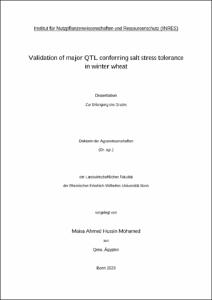Mohamed, Maisa Ahmed Hussin: Validation of major QTL conferring salt stress tolerance in winter wheat. - Bonn, 2023. - Dissertation, Rheinische Friedrich-Wilhelms-Universität Bonn.
Online-Ausgabe in bonndoc: https://nbn-resolving.org/urn:nbn:de:hbz:5-72696
Online-Ausgabe in bonndoc: https://nbn-resolving.org/urn:nbn:de:hbz:5-72696
@phdthesis{handle:20.500.11811/11102,
urn: https://nbn-resolving.org/urn:nbn:de:hbz:5-72696,
author = {{Maisa Ahmed Hussin Mohamed}},
title = {Validation of major QTL conferring salt stress tolerance in winter wheat},
school = {Rheinische Friedrich-Wilhelms-Universität Bonn},
year = 2023,
month = oct,
note = {Wheat is the third most important crop grown extensively worldwide, with global production and use estimated at 775.6 and 755.8 million tons, respectively. Despite its importance for global food security, its productivity has been severely reduced due to multiple abiotic stresses, including salinity, drought, cold, and ion toxicity. Salt stress is one of the most destructive abiotic stressors causing yield losses in wheat worldwide. Although there are several strategies to increase wheat production in salt-affected areas, such as leaching and drainage, the cultivation of salt-tolerant genotypes is estimated to be the most effective way to increase wheat production in agroecological regions with high soil salinity. A prerequisite for improving salt tolerance is the identification of adaptive traits for screening genotypes and uncovering causative genes. In this study, two populations of 274 and 277 F3 lines developed from crosses between Bobur (sensitive)*Altay2000 (tolerant) and Bobur*UZ-11CWA08 (tolerant) were tested for salinity tolerance at the seedling stage. As the progenies possessed high phenotypic and genetic variabilities in the measured traits, the genotypes could be classified as sensitive and tolerant. Under saline conditions, genotypes were considered tolerant when they had lower Na+ and proline contents, higher K+ and chlorophyll contents, a higher K+/Na+ ratio, higher rates of PSII activity, and higher photochemical efficiency compared to the sensitive ones. In the tested biparental populations, more than forty marker-trait associations have been tested, which have previously been described in a Genome Wide Association Study with a broad panel of cultivars. Of these marker-trait associations, five of them were polymorphic in the contrasting progenies, and one of them, namely Q-1DS on the short arm of chromosome 1D, showed a large quantitative trait locus (QTL) effect on dry root weight under salt stress. Several putative candidate genes underlying these five QTLs were identified. Expression analysis of the putative candidate genes showed that TraesCS1D02G052200 and TraesCS5B02G368800 had the highest expression levels in most of the organs and tissues, whereas they play important roles during development, growth, and grain filling. Additionally, the candidate genes that were validated in the parents were further validated in the contrasting lines for both segregating populations. This analysis revealed that ZIP-7 exhibited higher differential expressions compared to KefC, AtABC8, and 6-SFT under saline conditions. This study provides information on the genetic and molecular basis of salt tolerance that might be useful in developing salt-tolerant wheat cultivars.},
url = {https://hdl.handle.net/20.500.11811/11102}
}
urn: https://nbn-resolving.org/urn:nbn:de:hbz:5-72696,
author = {{Maisa Ahmed Hussin Mohamed}},
title = {Validation of major QTL conferring salt stress tolerance in winter wheat},
school = {Rheinische Friedrich-Wilhelms-Universität Bonn},
year = 2023,
month = oct,
note = {Wheat is the third most important crop grown extensively worldwide, with global production and use estimated at 775.6 and 755.8 million tons, respectively. Despite its importance for global food security, its productivity has been severely reduced due to multiple abiotic stresses, including salinity, drought, cold, and ion toxicity. Salt stress is one of the most destructive abiotic stressors causing yield losses in wheat worldwide. Although there are several strategies to increase wheat production in salt-affected areas, such as leaching and drainage, the cultivation of salt-tolerant genotypes is estimated to be the most effective way to increase wheat production in agroecological regions with high soil salinity. A prerequisite for improving salt tolerance is the identification of adaptive traits for screening genotypes and uncovering causative genes. In this study, two populations of 274 and 277 F3 lines developed from crosses between Bobur (sensitive)*Altay2000 (tolerant) and Bobur*UZ-11CWA08 (tolerant) were tested for salinity tolerance at the seedling stage. As the progenies possessed high phenotypic and genetic variabilities in the measured traits, the genotypes could be classified as sensitive and tolerant. Under saline conditions, genotypes were considered tolerant when they had lower Na+ and proline contents, higher K+ and chlorophyll contents, a higher K+/Na+ ratio, higher rates of PSII activity, and higher photochemical efficiency compared to the sensitive ones. In the tested biparental populations, more than forty marker-trait associations have been tested, which have previously been described in a Genome Wide Association Study with a broad panel of cultivars. Of these marker-trait associations, five of them were polymorphic in the contrasting progenies, and one of them, namely Q-1DS on the short arm of chromosome 1D, showed a large quantitative trait locus (QTL) effect on dry root weight under salt stress. Several putative candidate genes underlying these five QTLs were identified. Expression analysis of the putative candidate genes showed that TraesCS1D02G052200 and TraesCS5B02G368800 had the highest expression levels in most of the organs and tissues, whereas they play important roles during development, growth, and grain filling. Additionally, the candidate genes that were validated in the parents were further validated in the contrasting lines for both segregating populations. This analysis revealed that ZIP-7 exhibited higher differential expressions compared to KefC, AtABC8, and 6-SFT under saline conditions. This study provides information on the genetic and molecular basis of salt tolerance that might be useful in developing salt-tolerant wheat cultivars.},
url = {https://hdl.handle.net/20.500.11811/11102}
}






